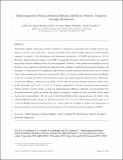| dc.contributor.author | Foo, Zi Hao | |
| dc.contributor.author | Rehman, Danyal | |
| dc.contributor.author | Coombs, Orisa Z. | |
| dc.contributor.author | Deshmukh, Akshay | |
| dc.contributor.author | Lienhard, John H | |
| dc.date.accessioned | 2021-10-27T17:21:35Z | |
| dc.date.available | 2021-10-27T17:21:35Z | |
| dc.date.issued | 2021-12 | |
| dc.date.submitted | 2021-08 | |
| dc.identifier.issn | 0376-7388 | |
| dc.identifier.uri | https://hdl.handle.net/1721.1/133175 | |
| dc.description.abstract | Osmotically-assisted membrane processes (OAMP) are separation technologies that leverage osmotic gradients to recover water from brine. Accurate modeling of the solute-coupling effects for transmembrane transport is integral to the development and subsequent optimization of OAMP unit operations. In the literature, multicomponent transport in OAMP is commonly linearized, and species fluxes are computed using binary solution-diffusion theory and then superposed. However, recent publications highlight the large predictive errors associated with such an approach as the transport coupling between species is ignored. In this paper, we demonstrate that significant improvements in multicomponent species fluxes can be obtained when solute-coupling interactions are incorporated. Here, we present a multicomponent solution-diffusion model, by extending the binary solution-diffusion model with multicomponent diffusion theory. When multicomponent diffusion coefficients are available, we find that the average absolute deviation (AAD) of the model decreased from 21.0% to 3.0% for 7 unique combinations of forward osmosis processes involving ternary mixtures. In the absence of data for multicomponent diffusion coefficients, we demonstrate that the multicomponent model can regress the impact of transport coupling on water and solute fluxes, using excess solute permeabilities. For the case of HO-NaCl-EtOH forward osmosis process, the AAD of the solution-diffusion model is shown to decrease from 66.1% to 7.2% for NaCl concentrations from 0.0 to 1.5 M and EtOH mass fractions from 0.0 to 0.5. These values are extended to analyze the implications on the thermodynamic and membrane area requirements of the desalination systems employing OAMP. | en_US |
| dc.publisher | Elsevier BV | en_US |
| dc.relation.isversionof | http://dx.doi.org/10.1016/j.memsci.2021.119819 | en_US |
| dc.rights | Creative Commons Attribution-Noncommercial-Share Alike | en_US |
| dc.rights.uri | http://creativecommons.org/licenses/by-nc-sa/4.0/ | en_US |
| dc.source | Prof. Lienhard | en_US |
| dc.title | Multicomponent Fickian solution-diffusion model for osmotic transport through membranes | en_US |
| dc.type | Article | en_US |
| dc.identifier.citation | Foo, Zi Hao et al. "Multicomponent Fickian solution-diffusion model for osmotic transport through membranes."Journal of Membrane Science 640 (December 2021): 119819. © 2021 Elsevier B.V. | en_US |
| dc.contributor.department | Massachusetts Institute of Technology. Department of Mechanical Engineering | en_US |
| dc.relation.journal | Journal of Membrane Science | en_US |
| dc.eprint.version | Author's final manuscript | en_US |
| dc.type.uri | http://purl.org/eprint/type/JournalArticle | en_US |
| eprint.status | http://purl.org/eprint/status/PeerReviewed | en_US |
| dspace.date.submission | 2021-10-26T18:49:39Z | |
| mit.journal.volume | 640 | en_US |
| mit.license | OPEN_ACCESS_POLICY | |
| mit.metadata.status | Complete | en_US |
